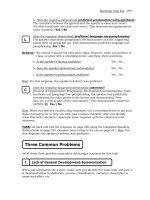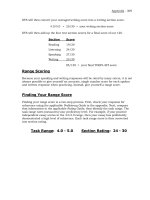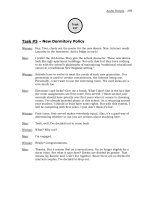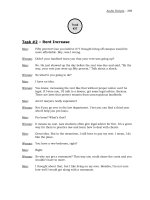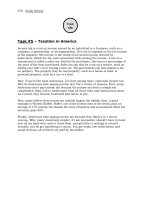SUBJECT MANAGEMENT AND SEARCH SUPPORTING FOR CURRICULUM MANAGEMENT SYSTEM
Bạn đang xem bản rút gọn của tài liệu. Xem và tải ngay bản đầy đủ của tài liệu tại đây (6.89 MB, 63 trang )
HANOI UNIVERSITY OF TECHNOLOGY, VIETNAM
HUT-MATI JOINT TRAINING PROGRAM
----------------------------
SUBJECT MANAGEMENT AND SEARCH SUPPORTING FOR
CURRICULUM MANAGEMENT SYSTEM
Advisor: Prof. Shilov V.V
Prof. Dr Nguyen Thi Viet Huong
Student: Nguyen Thi Loan
Hanoi, 2010
ACKNOWLEDGEMENT
When all the last parts of my project were finished and all the corrections were
made, I am so happy and proud for all I have done in the project developing process.
However, having the today’s results, first, I want to give a special thank to Prof. Shilov
V.V, my adviser. He helps me much during my project with a hard consultancy.
I would like to give special thank to Prof Dr. Nguyen Thi Viet Huong, who was very
dedicated. She has spent a lot of time on reviewing and editing my system analysis and
design as well as system developing process. She also makes an assistance and
consultancy to my documents, language and presentation
I would like to send my thanks to my lectures, friends, and family members who have
helped, encouraged and supported me enthusiastically to complete the project.
I also will never forget the kind support of other teachers as well as the staffs of Hanoi
University of Technology - MATI Joints Training program.
Hanoi, 2010
Student: Nguyen Thi Loan
TABLE OF CONTENTS
CHAPTER 1: INTRODUCTION TO SYSTEM.............................................1
1.1 Scenario......................................................................................................1
1.2 Project Feasibility.......................................................................................2
1.3 Project Scope..............................................................................................3
CHAPTER 2 – INTRODUCTION TO TECHNOLOGIES...........................5
2.1 Database Management System Assessment...............................................5
2.2 Programming Language Assessment..........................................................5
CHAPTER 3: SYSTEM ANALYSIS................................................................7
3.1 System requirement analysis......................................................................7
3.2 Processing Requirement Analysis of Exiting System.................................9
3.3. Data Requirement Analysis.....................................................................14
3.4 Function Requirement Analysis................................................................16
3.4.1 Function diagram...............................................................................16
3.4.2 Data Flow Diagram............................................................................19
CHAPTER 4: SYSTEM DESIGN..................................................................27
4.1 Database design........................................................................................27
4.1.1 Normalization.....................................................................................27
4.1.2 Entity Relationship Diagram..............................................................37
4.2 Interface design.........................................................................................38
4.3 Input design..............................................................................................38
4.4 Output design............................................................................................40
4.5 Program design.........................................................................................41
CHAPTER 5: INSTALLATION AND USER GUIDE..................................45
5.1Installation guide.......................................................................................45
5.2User guide..................................................................................................47
CONCLUSION.................................................................................................51
GLOSSARY......................................................................................................53
REFERENCE...................................................................................................54
CHAPTER 1: INTRODUCTION TO SYSTEM
1.1 Scenario
Today, Information Technology (IT) plays an important role in common life. It is the
most modern and helpful field to others. Education is one of the domains that IT has been
penetrating. This has brought many significant successes aiming to promote the
development of education.
The Genetic international training centre has started the technology-training program
since 1983. Genetic has short time and long-time training programs for awarding diploma
in information technology domain, software technique, computer language.
Genetic is a university education centre in forward-looking domains of information
technology. With the quick development, Genetic got a training network all over the
world. Genetic has had training centre in 33 other countries.
Hanoi University of Technology (HUT) - Genetic Singapore joint programmed was
set up in 1995, situated in Hanoi-Viet Nam. During 14 years' development, the
programmed has come over the difficult stages and has created a sustainable belief in
everyone about Vietnamese Education. Annually, there are hundreds of high-educated
students graduating and contributing to human resources in Information Technology of
Vietnam.
However, in fact, all curriculum management of this joint programmed is done manually
by some applications software. For examples: Microsoft Office Word, Microsoft Office
Excel and store in paper-based. Therefore, this now has some problems below: Spend a
lot of time and effort, difficult to search control and manage for a large amount of papers
and other unfortunate problems.
Basing upon the specific characteristics of HUT - Genetic Singapore joint
programmed and with purpose decrease these problems, we decided to build project to
solve and help staffs. This system focuses on program for curriculum management.
Manager will provide each staff with unique account. Therefore, staff can see all
information which relevant to curriculum. Staff can know all curriculum, subject and
batch information. From it, manager can view reports for batch, subject and curriculum
information.
1
It is so-called “Curriculum Management System”
Organization Chart of the Joint Program HUT-Genetic Singapore:
Figure 1.1: Organization Chart of the Joint Program HUT-Genetic Singapore
Describe the organizational chart:
System management of the Joint Program HUT-Genetic Singapore including:
-Center Director Head of Program: Supervise and manage the internal department,
receive information from Singapore to create programs for each course and each
speciality of Genetic school.
- Vice Center Director and Head of Program: Collect information from the different
department to edit and give accurate information to the Director.
- Officer: Reception and manages student records, manage school hours, class hours of
teachers and students.
- Inspector: Check and supervise action of departments in Genetic.
- Equipment Department: equip and provide teaching equipment and learning equipment
to strengthen teaching quality.
- Technical: make good and repair the problems or the problems relating to machines in
Genetic school.
- General Accountancy: collect and receive information relating to school activities.
1.2 Project Feasibility
This project is feasibility because it meets the following feasibility requirement:
- Economic Feasibility: The project does not require hight economic: Cost of building
software and implementation process is not much. Maintenance costs and infrastructure is
cheap. Machinery and needed equipment was available.
2
- Technical Feasibility: The program is designed on Windows with friendly interface
through windows and reports are easy to use.
- Operational Feasibility: Enter data is easy, friendly interface of program makes
operation process become easy with user.
Not require training time, officer has experience, and guide officer to use.
- Schedule Feasibility: We can control the schedule to develop this project on time.
1.3 Project Scope
Scope and function requirements:
Curriculum Management System is designed to help arranging batches and subjects
systematically as well as providing a mean for the managers to manage reports and
back up database of the system.
This project has the ability to manage information of curriculum, batch, course,
subject, and generate reports, backup and recovery management. Together with the
above main functions of the system, it extends some functions help managers easily
look up information of course, batch, subject, speciality.
The new system must contain the following sub functions:
Curriculum Management: the officers use this function to manage curriculums’
information. This function has some sub functions:
o Create new Curriculum
o Update Curriculum
o Delete Curriculum
o Print Curriculum
Batch Information Management: the officers use this function to manage the
batches’ information. This function has some other sub functions:
o Add new Batch
o Update Batch
o Delete Batch
o Search Batch
3
Course Information Management: the officers use this function to manage the
Course’ information. This function has some other sub functions:
o Add new Course
o Update Course
o Delete Course
o Search Course
Subject Information Management: the officers use this function to manage
subjects’ information. This function has some other sub functions:
o Add new Subject
o Update Subject
o Delete Subject
o Search Subject
Report: the officers use this function to create and view reports about Course,
Batch, Subject, Speciality.
Search Supporting: Support the officers search information about Curriculum,
Batch, Subject, Speciality.
Backup and Recovery: managers and training bureau use to backup and recovery
data.
Hardware requirement
Hardware
Recommended
Minimum
Processor
Pentium III 500 MHz (or faster)
Intel Pentium or Celeron 233 MHz
RAM
1024 MB (or higher)
512 MB
40 GB IDE
10 GB IDE
Hard disk
space
Video Adapter
AGP Card with 32 MB VRAM Super VGA card support display
(or higher)
mode: 16 bit color 800x600
resolution
Software requirement
Windows XP professional (Service Pack 2 or later) or Windows 2000 Professional
(Service Pack 2)
4
Microsoft SQL Server 2005 (Standard/Enterprise version)
Dot Net Framework 2005
CHAPTER 2 – INTRODUCTION TO TECHNOLOGIES
2.1 Database Management System Assessment
Database Management System (DBMS) is software or system is designed to
administer a database. Specifically, the programs of this type support the ability to store,
repair, delete and search for information in a database. There are many different DBMS:
from small software runs on personal computers to the complex management system
running on one or more supercomputer.
Nowadays, most DBMS on the market has a common feature is use the query
language, which is called Structured Query Language (SQL). The database management
system is more commonly known as MySQL, Oracle, PostgreSQL, SQL Server, Infomix,
etc.
However, in my project, I chose SQL Server 2005 because it has the following
particularitys:
- Allows manage a large database up to Tera-Byte and may serve thousands of users
simultaneously,
data
processing
speed
is
fast,
satisfy
time
requirements.
- SQL Server 2005 has reduced application downtime, increased scalability and
performance, and tight yet flexible security controls.
- SQL Server 2005 makes it simpler and easier to deploy, manage, and optimize
enterprise data and analytical applications. It enables you to monitor, manage, and tune all
of the databases in the effective way.
2.2 Programming Language Assessment
A programming language is an artificial language used to write a sequence of
instructions (a computer program) that can be run by a computer. The languages used to
program computers must have simple logical structures, and the rules for their grammar,
spelling, and punctuation must be precise. There are many different languages and each
language has a particular nature different.
5
However, in my project, I chose C# because:
Visual Studio.Net is the new object oriented programming language that is written
by Microsoft to create a new standard for programming language. It is powerful
programming language with four major languages: C#, VB.Net, Java… However, in this
type of programming language, C# is simple, modern, and object-oriented and type safe
programming language delivered from C and C++, and bears or striking similarity to Java
in many ways. C# is a modern, type safe programming language, object oriented
language that enables programmers quickly and easy. C# is a masterpiece evolved from
today’s most popular languages and has all the best features borrowed from VB, C++ and
Java. Therefore, it is a great choice for architecting a wide range of component from
higher-level business objects to system level application. Using simple C# language
constructs, these components can be converted into XML Web services, allowing them to
be involved across the Internet, from any language running on any operating system. The
C# language allows for typed, extensible metadata that can be applied to any object. A
project architect can define domain specific attributes and so on… The developer then
can programmatically examine the attributed on each element.
It is easy to realize that C# is the best choice to develop this project.
6
CHAPTER 3: SYSTEM ANALYSIS
3.1 System requirement analysis
Because program management system of Genetic center ever be completely done by
hand, so there are many disadvantages as it is difficult to find the corresponding subject
to academic year, batch, course, term. Moreover, it is very hard for managers and training
bureau in the statistical report. A very important problem is that when a document is lost,
no opportunity to recover. In addition, cannot find the list of subjects if not meeting the
manager, the last problem is the manager will meet many difficulties in preparing a
detailed report.
From these reasons, we need a program that functions as the simplest:
System Management: Includes user management function and distribution of
power between administrator and users.
Batch, Course, Term, Class Management: manager and training bureau use to
manage the batches’ information. This function has sub functions: add new, update,
delete data.
Subject Management: manager and training bureau use to manage subjects’
information. This function has sub functions: Add new Subject, Update Subject,
and Search Subject.
Curriculum Management: manager and training bureau use to manage
curriculums’ information. This function has sub functions: Create new Curriculum,
Update Curriculum, and Print Curriculum.
Search supporting for curriculum management system: managers and training
bureau use to search information about curriculum, batch, subject, speciality.
Report Management: managers and training bureau use to manage reports and
show reports about Course, Batch, Subject, Speciality.
Backup and Recovery: managers and training bureau use to backup and recovery
data.
7
Help: Introduction about us and the Joint Program HUT-Genetic Singapore and
user guide
However, in this project, I would focus on “Subject management and Search
supporting for curriculum management system”. This is a very important part of the
“Curriculum management system”.
Base on system requirement analysis, we can build the following Function Diagram:
Function Diagram
Figure 3.1.1: Function Diagram for Curriculum Management System (CMS)
8
3.2 Processing Requirement Analysis of Exiting System
1. Beginning of the academic year, training bureau draw up a list of batches, courses, classes
Information Processing:
and specialities to divide and create the list of subjects for each batch and each class. (Figure
3.2.2 List of batch, class in curriculum year)
2. In each batch, training bureau draw up a list of subject for each batch and speciality to
classify for each exam type of subjects, which that batch must learn. (Figure 3.2.3 List of
Subjects)
3. Training bureau receive information about batches, classes, and subjects from Director to
draw up the list of subjects for each subject and number of hours for each subject of each batch.
(Figure 3.2.4 Study Period)
4. Provide reports for batch, course, class, academic year, speciality and exam type for each
subject
Figure 3.2.1: Information Processing
Beginning of process information is collect data about batch, class, academic year.
This part is managed by Vietnam and in yearly April is the latest period to finish for next
year. Center director head of the program manage this part. Example: form of “List of
batch, class, academic year”
Academic 2009 – 2010
* Batch: D10, D11, D12, D13
* Class
Batch
D13
D12
D11
D10
Class
…B…C…E…
…B…C…E…
…B…C…E…
…B…C…E…
9
Figure 3.2.2: List of batch, class in curriculum year
10
After collecting data about batches and classes, we collect data about subject
list. This part is compiled and sends to Vietnam by Singapore side.
HUT – GENETIC Center – Viet Nam
DS1
Subject
Batch
No
1
2
3
4
5
Course
Diploma
6
7
8
9
10
11
12
13
14
15
16
17
18
19
20
21
22
23
1
2
3
4
5
Subject
A+
ASP.NET
Exam Code
MCQ A+
MCQ+ ASP
Wr
Business Accounting
BA
Business Organization
BO
Computer System
MCQ+ CS
Wr
Database Design using SQL sever MCQ SQL
DHTML and Java script
Lab
HTML
E-Commerce
E.com
English – E3
E3
iNet +
MCQ iNet
Inter personal Skill
IPS
Management Information System MCQ+ MIS
Wr
Maths
Math
Networks +
MCQ Net+
Object Oriented Design
OOD
Oracle
MCQ+ Oracle
Wr
Programming Technique using MCQ+ Java
Java
Wr
Programming using C#
Lab
C#
Systems Analysis and Design
SAD
VB.NET Programming
Lab
VB
Web
and
Multimedial MCQ Web
Development
Windows 2000 sever
MCQ Win20
00
Office Application Web
Lab
OAW
Advance Programming using C # Lab
Adv.C#
Advance VB.NET Pro
Lab
Adv.V
B
Artificial Intelligence
AI
Computer Architecture
CA
Computer Ethics and Security
CES
11
Course
Higher
Diploma
6
7
8
9
10
11
12
13
Data Communication
Distributed System
E-Business Development
Enterprise Solution Architecture
Hardware Systems Design
Information
Resource
Management
Internet Technologies
Java Programming
Lab
14
15
16
17
18
19
Knowledge Based System
Linux System Administration
Mobile Computing
Operation System
Programming Language
Software Engineering
MCQ
MCQ
DA
DS
E-Bus
ESA
HSD
IRM
IT
Java
Pro
KBS
Linux
MC
OS
PL
SE
Figure 3.2.3: List of Subjects
After receive subject list, center director head of the program will base on list
of batches, classes to assign each subject and timetable each term to each class.
1st
Term
2nd
Tern
3rd
Term
Academic Year
Diploma -1st year
1.Computer
SystemFundamental(Wr)
2.Computer
SystemArchitecture(Wr)
3.Office
Application
with
Web(Lab)
4.MathematicsAlgera&Calculate(Wr)
5.Mathematics-Discrete(Wr)
6.English E3(Wr)
1.VB.Net Programming(Lab)
2.Inter Personal Skill(Wr)
3.Programming using C#(Lab)
4.A+(Wr)
5.Net+ (Wr)
6.English E3(Wr)
Diploma -2nd year
1.Database
Design
using
SQLserver(Wr)
Total Hours Theo.Hours Lab.Hours
Hours /week /week
/week
153
9
9
0
0
153
9
5
3
1
136
8
8
0
0
70
56
5
4
3
4
2
0
0
0
112
70
70
8
5
5
5
4
4
2
1
1
1
0
0
70
5
4
1
0
12
C
C
E
E
B
B
4th
Term
1st
Term
2nd
Term
3rd
Term
4th
Term
C
2.Window 2000 server (Wr)
3.DHTML and java script(Lab)
4.Object Oriented Design(Wr)
5.Web
and
Multimedia
Development(Wr)
4.E-Commerce(Wr)
5.iNet +(Wr)
4.Bussiness Accounting(Wr)
5.Bussiness Organization
1.Oracle8i(Wr)
2.Programming
Technique
UsingJave(Lab)
3.Management
Information
System(Wr)
4.System
Analysis
and
Design(Wr)
5.ASP.Net(Wr)
Diploma Project
Higher Diploma 1st-year
74
102
68
4
6
4
4
3
4
0
2
0
0
1
0
68
68
68
68
68
119
4
4
4
4
4
7
3
4
4
4
4
5
1
0
0
0
0
2
0
0
0
0
0
0
70
5
4
1
0
70
5
5
0
0
70
70
5
5
4
4
1
1
0
0
1.Operating System (Wr)
2.Computer Architecture(Wr)
3.Programming Language(Wr)
4.Advance Programming using
C#(Lab)
1.Knowledge Based System
70
85
85
5
5
5
5
4
5
0
1
0
0
0
0
136
70
8
5
5
5
2
0
1
0
2.Linux Sys.Administration(Wr)
3.Data Communication (Wr)
4.Hardware System Design(Wr)
5.Advance
VB.Net
Programming(Lab)
Higher Diploma 2nd-year
1.Computer
Ethics
and
Security(Wr)
85
70
70
5
5
5
4
5
5
1
0
0
0
0
0
70
5
3
2
0
85
5
5
0
0
2.Software Engineering(Wr)
3.Distributed System(Wr)
4.Mobile Computing(Wr)
5.Java Programming (Lab)
6.Start Team Project
85
85
85
119
5
5
5
7
5
5
4
4
0
0
1
2
0
0
0
1
6
6
6
6
6
6
0
0
0
0
0
0
1.Artificial Intelligence (Wr)
84
2.E-Business Development(Wr) 90
3.Enterprise
Solution 90
13
E
B
Architure(Wr)
3.Internet Technologies(Wr)
90
3.Information
Resource
Management(Wr)
70
4.English E4 (Wr)
5.Complete Team Project
6
6
0
0
5
5
0
0
Figure 3.2.4: Study Period
Figure 3.2.5: Study Plan
14
3.3. Data Requirement Analysis
According processing, the second step is analysis sample without value.
Base on “List of batch, class in academic year” (Figure 3.2.2), we have
explained table as the following:
No
Field
Meaning
Example
Valid Data
1
AcademicYear
2009-2010
Number
2
BatchName
Academic
Year which
has batches,
classes
Batches in
Academic
Year
D11,
D10…
Text
3
Classes
Classes in
Academic
Year
D10-B63,
D10-I1
Text
Value
Processing
functions
-
Add
Delete
Search
Update
Add
Delete
Search
Update
Add
Delete
Search
Update
Figure 3.3.1: Table to analyze Sample “List of batch, class, academic
year” (Figure 3.2.2)
After that, we analyze second sample: “Subject List” (Figure 3.2.3), we have
the explained table like:
No Field
1
2
Meaning Example
Subject
List for
SubjectListID
List1,List2
each
year
Basic,
Courses
Diploma,
Course
in
Higher
process
diploma
3
SubjectID
4
SubjectName
ID
for
AI,
each
VB.NET
Subject
Subject
Name
Valid
Data
Text
Text
Text
Bussiness
Text
Accounting
Value Processing
functions
- Add
- Delete
- Search
- Update
-
Add
Delete
Search
Update
-
Add
Delete
Search
Update
Add
Delete
15
5
ExamType
Exam
Type of Wring,
each
MCQ
subject
Text
-
Search
Update
Add
Delete
Search
Update
Figure 3.3.2: Table to analyze Sample “Subject List” (Figure 3.2.3)
Finally, we analyze sample: “Study Period”
No Field
Meaning
Example
1
BatchID
Batch in
training
process
D10,
D12
Course
Courses in
training
process
Basic,
diploma,
higher
diploma
Term
Terms in
Academic
Year
Term
Term 2
4
TotalHours
Total Hours
of each
Subject
200
Number
5
StudyHoursIn Study Hours
Week
in a week
20
Number
6
TheoryHours
Theory
Hours in
week
10
Number
7
PracticeHours
Practice
2
Hours in wek
2
3
Valid
Data
D11,
Value
Text
Text
1,
Text
Number
Processing
functions
- Add
- Delete
- Search
- Update
- Add
- Delete
- Search
- Update
-
Add
Delete
Search
Update
Add
Delete
Search
Update
Add
Delete
Search
Update
Add
Delete
Search
Update
Add
Delete
Search
Update
Figure 3.3.3: Table to analyze Sample: “Study Period” (Figure 3.2.4)
16
3.4 Function Requirement Analysis
3.4.1 Function diagram
A functional diagram is used to show system’s functions that will be
constructed and the implementation process of data diagram. Moreover,
function diagram will also be used to determine the appearance frequency
of smaller process in the data flow chart.
A functional diagram only shows what to do not how to do. In a
functional diagram, a function is divided into many smaller functions and
each smaller function contains even smaller ones. Constructing diagram is a
process of division, from a higher function to appropriate smaller functions.
Diagrams need to be presented clearly, simply, exactly, fully, and well
balanced. Function of the same level has the same level of difficulty need to
be on the same page.
Base on function requirement about system, we can build the following
Function Diagram:
Figure 3.4.1.1: Function Diagram
Explain the function
17
System Management:
Includes user management function and
distribution of power between managers and users.
Batch, Course, Term, Class Management: manager and training bureau
use to manage information of batches, course, term, class. This function has
sub functions: add new, update, delete data.
Subject management: Beginning academic year, after collecting
complete data about courses and classes, we collected data on the list of
subjects; the list of subject compiled and sent to Vietnam by Singapore.
Subject management include three sub functions are:
- Add new subject: After receiving the subjects list, if subjects list
has new subjects, the officer will use the "Add new subject" function to
create new subjects. Data of subject include: subject name, total hours
of subject, the subject is theory hours or practice hours; exam type of
subject, and information about speciality…will be saved in the subject
database.
- Update subject: During academic year, when needs change data of
subjects, the manager will use the "Edit subject" function to update
data for subjects. Information about subjects will be changed and
saved to the subject database.
- Delete subject: At the beginning of academic year, if the
curriculum changes, subjects list from Singapore do not have older
subjects, the manager will delete this subject by “Delete subject”
function. All information about subjects will be deleted and not exist in
the subject database.
Each subject has a different type of exam, example: writing,
laboratory, multi choice question. Therefore, in “Subject management”
includes “Exam type management” function. This function allow
officer manage information of exam type. Officer can add new, edit and
delete exam type.
18
Curriculum Management: Manager and training bureau use to manage
curriculums’ information. This function has sub functions: Create new
Curriculum, Update Curriculum, and Print Curriculum.
Search supporting for curriculum management system: When
students have questions about the curriculum, batch, subject, specility,
the manager (training bureau) will use the “Search supporting for
curriculum management system” function to find information and
answers to students. With large amounts of data, search supporting
system helps managers can find information quickly, easily operation,
saving time. Search supporting for curriculum management system
include four sub functions are:
- Search curriculum: When managers want to find information
about curriculum, they will use the “Search curriculum” function. The
system checks the information in the curriculum database. Then the
database will reply information for system. The system process
information and sent feedback for manager about academic year, start
date of first term, end date of first term, start date of second term, end
date of second term…
- Search batch: To search information about batch, manager use
“Search batch” function. The system checks the information in the
batch database. Then the database will reply information for system.
The system process information and sent feedback for manager about:
batch name, start year of batch, end diploma year, end higher diploma
year…
- Search subject: When managers want to find information about
subject, manager use “Search subject” function. The system checks the
information in the subject database. Then the database will reply
information for system. The system process information and sent
feedback for manager about: subject name, total hours of subject, the
subject is theory hours or practice hours, exam type of subject…
19
- Search speciality: If manager want to find information about
speciality, manager will use “Search speciality” function. The system
checks the information in the speciality database. Then the database
will reply information for system. The system process information and
sent feedback for manager about speciality code, speciality name…
Report Management: managers and training bureau use to manage
reports and show reports about Course, Batch, Subject, Speciality.
Backup and Recovery: managers and training bureau use to backup and
recovery data.
Help: Introduction about us and the Joint Program HUT-Genetic
Singapore and user guide
3.4.2 Data Flow Diagram
The Data Flow Diagram shows the flow of data or information through an
information system in a graphical top-down fashion. DFDs are not used to
show the logic of a program or any detailed processing logic. It can be
partitioned into single processes or functions. Data Flow Diagrams can be
grouped together or decomposed into multiple processes
DFD Symbols:
Process
Process
Symbol: Circle, or a Rounded Rectangle
A process modifies, or changes, data from one form to another form.
That is, data is input to a process, and the process transforms this data to
produce output data of a different content or form. The details of a process are
20
not shown in the data flow diagram; these details are documented in the
process description.
When modelling the data processing of a system, it doesn’t matter whether a
process is performed manually or by a computer.
Data Store
Data Store
Symbol: Two parallel lines, or an open ended rectangle
A data store is a data repository. A data store may represent one of many
different physical locations for data, for example, a file folder, one or more
computer-based file(s), or a notebook. A data store is used in a data flow
diagram when the system must store data because one or more processes need
to use the stored data at a later time. The detailed contents of a data store are
not shown in a data flow diagram; these contents are defined in the data
dictionary.
External Entity
External Entity
Symbol: rectangular box
An external entity is a person, department, outside organization, or other
information system that provides data to the system or receives data or
information from the system. External entities showed the boundaries of the
information system or the information system’s interactions with the outside
world.
External entities are also called terminators. An external entity that
supplies data is called a source, or origin. An external entity that receives data
21
